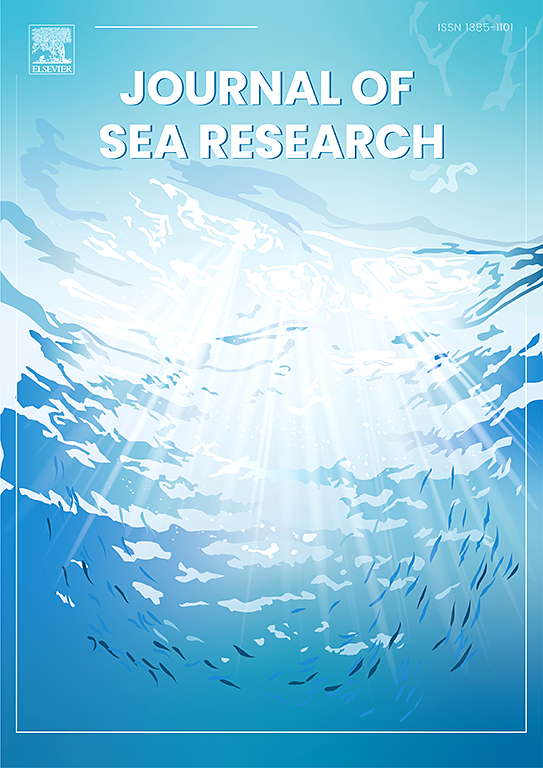Laying out the foundations: Assessing the spatial extent and drivers of offshore wind turbine artificial reef effects on soft sediments
IF 2.9
4区 地球科学
Q2 MARINE & FRESHWATER BIOLOGY
引用次数: 0
Abstract
With the rapid expansion of offshore energy, numerous artificial structures are being installed on the seabed, including wind turbine foundations. This study investigates the “artificial reef” (AR) effect of bottom-fixed offshore wind farms (OWFs) on soft sediment benthic communities. While previous studies have focused on distances ≥30 m from turbines, in this study, sediment and macrobenthic samples were collected at shorter distances (1 m, 7 m, 15 m and 25 m) from the scour protection layer (SPL) around a monopile and a gravity-based foundation in two Belgian OWFs, 10–13 years post-installation. Results show a localized AR footprint for both turbine foundations, with enriched benthic communities within 15 m of the SPL. In comparison to communities 25 m distanced away from the SPL, a higher average species richness (+100 %), abundance (+117 %), functional richness (+438 %), and bioturbation potential (+86 %) was prevalent, whereas the magnitude of enriched structural and functional diversity in the footprint varied respectively between 16 and 80 % and 15–110 % depending on the OWF. Beyond the AR footprint, communities resembled those at reference sites (240–570 m), with less surface dwellers, suspension feeders and a prevalence of burrowing biodiffusors that contribute little to bioturbation. While the AR effect's magnitude depends on local conditions and foundation design, our trait-based analysis indicates that sediment fining, biofouling drop-offs and organic enrichment are consistent drivers shaping the AR footprint.
奠定基础:海上风力机人工鱼礁对软沉积物影响的空间范围及驱动因素评估
随着海上能源的迅速发展,许多人工结构被安装在海床上,包括风力涡轮机的基础。本研究探讨了固定式海上风电场(OWFs)对软沉积物底栖生物群落的“人工礁”(AR)效应。虽然之前的研究主要集中在距离涡轮机≥30米的距离上,但在本研究中,沉积物和大型底栖动物样本是在安装后10-13年的两个比利时owf中,在距离单桩和重力基础周围的冲刷保护层(SPL)较短的距离(1 m, 7 m, 15 m和25 m)处收集的。结果表明,两个涡轮机基础都有局部的AR足迹,在距SPL 15 m范围内有丰富的底栖生物群落。与距离SPL 25 m的群落相比,平均物种丰富度(+ 100%)、丰度(+ 117%)、功能丰富度(+ 438%)和生物扰动潜力(+ 86%)普遍较高,而结构和功能多样性的富集幅度分别在16 - 80%和15 - 110%之间。在AR足迹之外,群落与参考点(240-570 m)相似,地表居民较少,悬浮取食者较少,穴居生物扩散器普遍存在,对生物扰动贡献不大。虽然AR效应的大小取决于当地条件和基础设计,但我们基于特征的分析表明,沉积物细化、生物污染下降和有机富集是形成AR足迹的一致驱动因素。
本文章由计算机程序翻译,如有差异,请以英文原文为准。
求助全文
约1分钟内获得全文
求助全文
来源期刊

Journal of Sea Research
地学-海洋学
CiteScore
3.20
自引率
5.00%
发文量
86
审稿时长
6-12 weeks
期刊介绍:
The Journal of Sea Research is an international and multidisciplinary periodical on marine research, with an emphasis on the functioning of marine ecosystems in coastal and shelf seas, including intertidal, estuarine and brackish environments. As several subdisciplines add to this aim, manuscripts are welcome from the fields of marine biology, marine chemistry, marine sedimentology and physical oceanography, provided they add to the understanding of ecosystem processes.
 求助内容:
求助内容: 应助结果提醒方式:
应助结果提醒方式:


